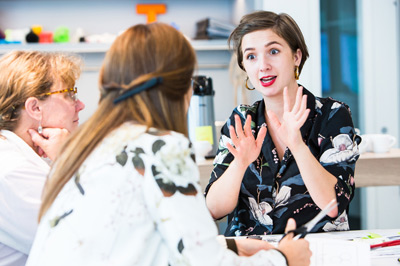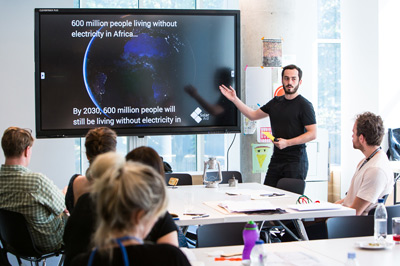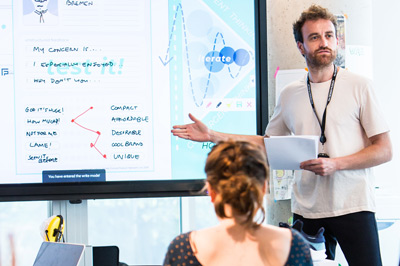
The Design Museum’s Teacher Summer School took place on 23rd – 25th July and was led by designer and creative director of Future Product, Henry James. Henry helped to design the SM100 light that makes up part of the Design Museum’s handling collection and is a staple of the Museum’s national outreach programme.
Over the course of three days the teachers were asked to create a design brief, make a prototype and then test it with museum visitors. Jamie McCloskey, SolarAid’s Head of Programme Funding, gave a talk on day three.
David Houston, Learning Producer – Schools at The Design Museum said:
“Jamie’s talk really hit key points throughout the Teacher Summer School. Many of the ideas generated by teachers on day one had a social and environmental heart behind them so it was great to hear of the amazing work carried in countries like Malawi. The teachers also benefited from Jamie’s insights into the market research carried out with thousands of families just before they went off to conduct their testing of their own designs with visitors.”
 Jamie loves events like this where he gets to tell more people about the amazing work of SolarAid and SunnyMoney:
Jamie loves events like this where he gets to tell more people about the amazing work of SolarAid and SunnyMoney:
“It was fantastic to be a part of the Summer School. My talk was about SolarAid’s collection and use of impact and market research. We collected over 30,000 direct research interactions over 5 years to help us understand how relying on poor energy sources limits life. So, I gave examples of how this data has been used to further our distribution model, products and impact.
For example, we’ve used our research when working with agents to introduce tiered structures, financing, and training in response to feedback. We also drew on our research when designing pay-as-you-go (PAYG) systems and new financing options to lower the affordability barrier. My final example was about the SM100 and I told the story of its development from conception (using our research during the design process), focus groups (where feedback was that it was too small, and needed a whiter light) to its launch and scaling up production and sales.
I finished by explaining that further data needs to be collected to influence the necessary innovation to reach the 600 million without electricity and meet SDG7.”
 Henry James, Creative Director at Future Product, said:
Henry James, Creative Director at Future Product, said:
“I’ve been working with the Design Museum’s educational outreach programme Design Ventura and its CPD sessions for teachers since 2016, when the museum moved locations. I’m an advocate for its work to bring design stories to the wider public. This includes bringing attention to the unsung heroes behind impact-full product design – the researchers, analysts and social pioneers who provide the insights on which good design is founded.
Designers are increasingly shifting their attention from making things to making impact. Design which challenges social inequity forms a central thread of my talks and creative workshops for young people and teachers. The SM100 is my ‘go-to’ design for demonstrating the role user insights have on shaping disruptive products and their business models. The product is easily relatable – a simple response to a complex challenge – and illustrates how designers, users and makers must collaborate to create lasting change.”
You can buy your own solar light in the SolarAid shop – and each one you buy will help get another one to Africa.
